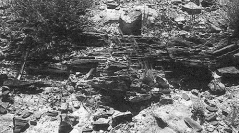

 Comptes Rendus Palevol
6 (1-2) - Pages 115-124
Comptes Rendus Palevol
6 (1-2) - Pages 115-124The recent discovery of numerous localities with Bathonian to Albian plants imprints in southern Tunisia (Tataouine area) has permitted to define six main types of plant taphofacies: marine deposits with floated trunks, channels with eroded/rounded fern axes, inundated forests, hypo-autochthonous accumulations, autochthonous riparian herbaceous formations. Their relation with sedimentology is presented. These taphofacies represent both the installation of pioneering vegetation submitted to marine-level fluctuations and the establishment of conifers and fern forests fossilized in autochthonous position, but also sometimes subjected to transport over a short distance to meandering fluvial system.
Plants adpressions, fossil woods, taphonomy, sedimentology, Jurassic–Cretaceous, South-Tunisia